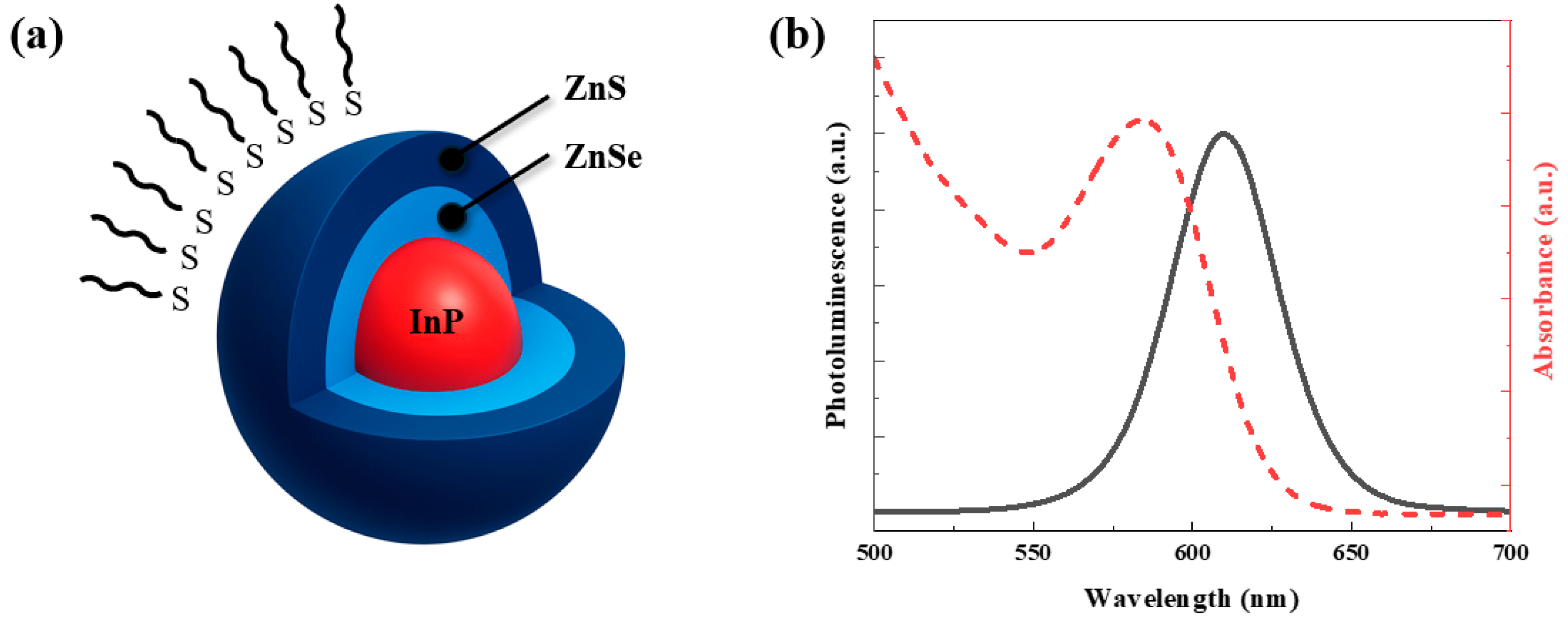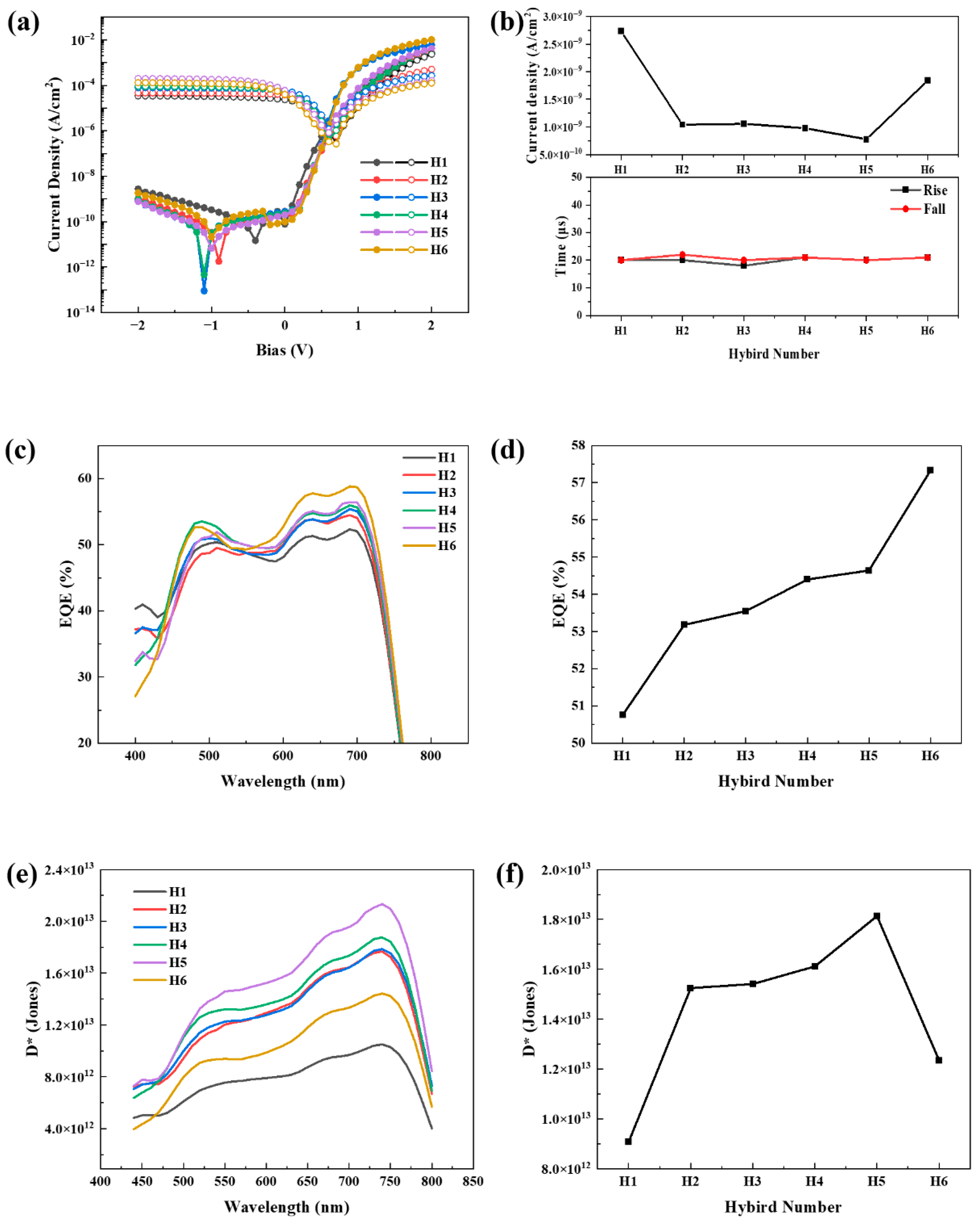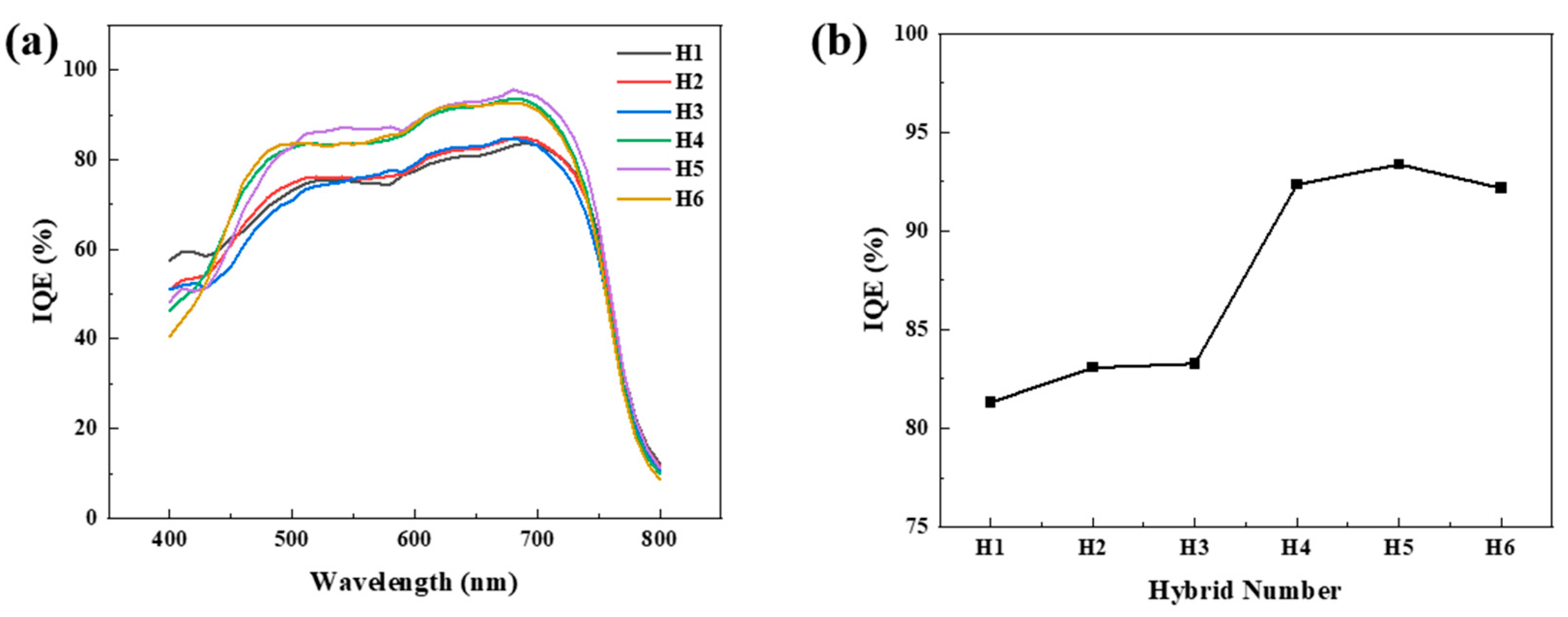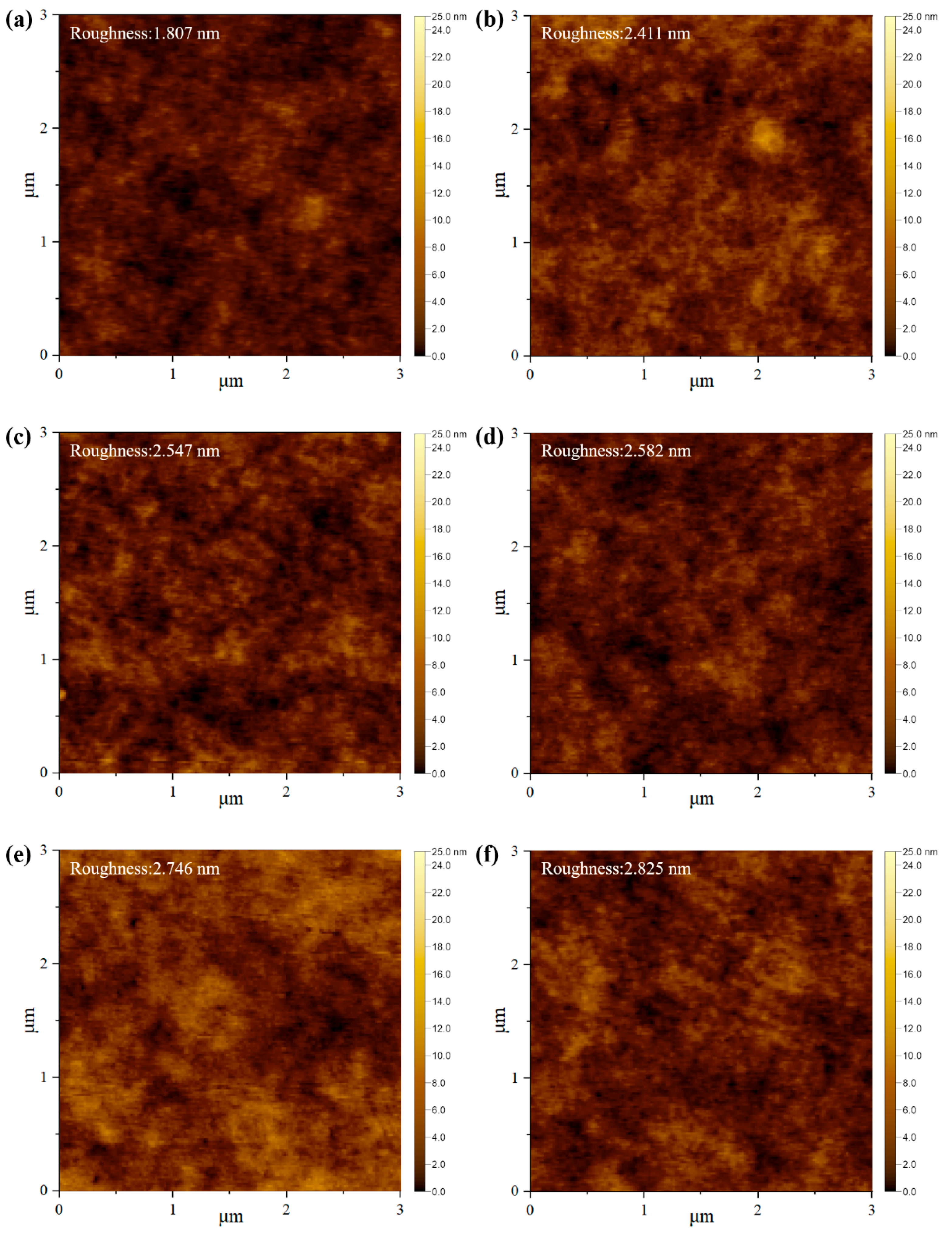High-Detectivity Organic Photodetector with InP Quantum Dots in PTB7-Th:PC71BM Ternary Bulk Heterojunction
Abstract
1. Introduction
2. Materials and Methods
2.1. Materials
2.2. Methods
3. Results and Discussion
3.1. Characterization
3.2. Photophysical Properties of InP/ZnSe/ZnS QDs in BHJ Matrix
3.3. UV–Vis Absorption and Photoluminescence Quenching in PTB7-Th:InP/ZnSe/ZnS QDs Hybrid Films
3.4. Electrical Characteristics of PTB7-Th:PC71BM:InP/ZnSe/ZnS QDs Hybrid OPDs
3.5. Surface Morphology of the PTB7-Th:PC71BM:InP/ZnSe/ZnS QD BHJ Film
3.6. Photoplethysmographic Signal Acquisition and SNR Enhancement

4. Conclusions
Supplementary Materials
Author Contributions
Funding
Data Availability Statement
Conflicts of Interest
References
- Shan, C.; Wang, Y.; Luo, D.; Dai, T.; Xu, X.; Gu, X.; Xu, X.; Zhou, E.; Zhao, T.; Kyaw, A.K.K. High Detectivity in Photomultiplication-Type Organic Photodetectors: A Study on EQE and Dark Current Balance via Processing Methods. Adv. Mater. Technol. 2025, 10, 2401574. [Google Scholar] [CrossRef]
- Ji, J.; Sharma, R.; Kim, T.J.; Seok, J.; Shin, H.; Esteban, C.M.; Lee, W.; Choi, D.; Oh, S.; Yu, K.; et al. Impact of the Resonant Cavity Order on the Performance of the PTB7-Th Polymer and Nonfullerene Acceptor Blend Near-Infrared Organic Photodiodes. ACS Appl. Polym. Mater. 2025, 7, 2043–2052. [Google Scholar] [CrossRef]
- Shan, T.; Li, J.; Bai, Q.; Zhang, M.; Shi, R.; Zhong, H.; He, B.; Li, S.; Guo, X. Self-Assembled Monolayer Assisted Biphasic Heterojunction Organic Photodiode for Panel-Level Manufacturing of Active-Matrix Optical Imager. Adv. Funct. Mater. 2025, 35, 2419941. [Google Scholar] [CrossRef]
- Jiang, B.H.; Weng, P.J.; Su, Y.W.; Shi, Z.E.; Lin, Y.R.; Shieh, T.S.; Chen, C.P. Minimizing Thermally Activated Carrier Generation for Ultra-Low Dark Current Density and Enhanced Thermal Stability in Air-Stable All-Polymer Photodetectors. Macromolecules 2025, 58, 3983–3992. [Google Scholar] [CrossRef]
- Chen, Z.; Huang, T.; Zhang, B.; Wu, C.; Zhang, X.; Sun, T.; Xu, W.; Kang, K.; Xiang, C.; Zhang, T.; et al. Suppression of the Dark Current in PbS Quantum Dot Infrared Photodetectors through the Introduction of a CuInSeS Interfacial Layer. J. Mater. Chem. C 2024, 12, 4493–4500. [Google Scholar] [CrossRef]
- Todor-Boer, O.; Petrovai, I.; Tarcan, R.; David, L.; Astilean, S.; Botiz, I. Control of Microstructure in Polymer: Fullerene Active Films by Convective Self-Assembly. Thin Solid Films 2020, 697, 137780. [Google Scholar] [CrossRef]
- Chern, M.; Kays, J.C.; Bhuckory, S.; Dennis, A.M. Sensing with Photoluminescent Semiconductor Quantum Dots. Methods Appl. Fluoresc. 2019, 7, 012005. [Google Scholar] [CrossRef]
- Han, Y.W.; Jeon, S.J.; Choi, J.Y.; Kim, J.H.; Moon, D.K. Highly Efficient Ternary Solar Cells of 10.2% with Core/Shell Quantum Dots via FRET Effect. Sol. RRL 2018, 2, 1870206. [Google Scholar] [CrossRef]
- Li, S.; Wang, Z.; Robertz, B.; Neumaier, D.; Txoperena, O.; Maestre, A.; Zurutuza, A.; Bower, C.; Rushton, A.; Liu, Y.; et al. Graphene-PbS Quantum Dot Hybrid Photodetectors from 200 mm Wafer Scale Processing. Sci. Rep. 2025, 15, 14706. [Google Scholar] [CrossRef]
- Hu, L.; Wan, T.; Guan, X.; Li, Z.; Mei, T.; Dong, B.; Gao, L.; Chen, C.; Li, X.; Lin, C.H.; et al. Ligand Engineering Enables Bifacial PbS All-QD Homojunction Photodiodes. Adv. Funct. Mater. 2025, 35, 2419316. [Google Scholar] [CrossRef]
- Xu, Q.; Meng, L.; Sinha, K.; Chowdhury, F.I.; Hu, J.; Wang, X. Ultrafast Colloidal Quantum Dot Infrared Photodiode. ACS Photonics 2020, 7, 1297–1303. [Google Scholar] [CrossRef]
- Yin, X.; Zhang, C.; Guo, Y.; Yang, Y.; Xing, Y.; Que, W. PbS QD-Based Photodetectors: Future-Oriented near-Infrared Detection Technology. J. Mater. Chem. C 2021, 9, 417–438. [Google Scholar] [CrossRef]
- Tang, Y.; Wu, F.; Chen, F.; Zhou, Y.; Wang, P.; Long, M.; Zhou, W.; Ning, Z.; He, J.; Gong, F.; et al. A Colloidal-Quantum-Dot Infrared Photodiode with High Photoconductive Gain. Small 2018, 14, 1803158. [Google Scholar] [CrossRef] [PubMed]
- Yang, X.-K.; Qiao, J.-W.; Chen, Z.-H.; Wen, Z.C.; Yin, H.; Hao, X.-T. CdSe Quantum Dot Organic Solar Cells with Improved Photovoltaic Performance. J. Phys. D Appl. Phys. 2021, 54, 115504. [Google Scholar] [CrossRef]
- Selopal, G.S.; Zhao, H.; Wang, Z.M.; Rosei, F. Core/Shell Quantum Dots Solar Cells. Adv. Funct. Mater. 2020, 30, 1908762. [Google Scholar] [CrossRef]
- Zeng, W.; Duan, Z.; Bu, Y.; Yu, H.; Wang, C.; Tang, X.; Yang, J.; Yuan, Z.; Jiang, Y.; Tai, H. A Self-Powered HgTe Quantum Dots/PBDB-T:Y6 Bipolar Broadband Photodetector for Logic Gates. Mater. Horiz. 2025, 12, 2179–2186. [Google Scholar] [CrossRef]
- Jin, L.; Selopal, G.S.; Tong, X.; Perepichka, D.F.; Wang, Z.M.; Rosei, F. Heavy-Metal-Free Colloidal Quantum Dots: Progress and Opportunities in Solar Technologies. Adv. Mater. 2024, 36, 2402912. [Google Scholar] [CrossRef]
- Zhang, J.; Zhang, S.; Zhang, Y.; Al-Hartomy, O.A.; Wageh, S.; Al-Sehemi, A.G.; Hao, Y.; Gao, L.; Wang, H.; Zhang, H. Colloidal Quantum Dots: Synthesis, Composition, Structure, and Emerging Optoelectronic Applications. Laser Photon Rev. 2023, 17, 2200551. [Google Scholar] [CrossRef]
- Lin, Y.; Wang, J.; Zhang, Z.G.; Bai, H.; Li, Y.; Zhu, D.; Zhan, X. An Electron Acceptor Challenging Fullerenes for Efficient Polymer Solar Cells. Adv. Mater. 2015, 27, 1170–1174. [Google Scholar] [CrossRef]
- Cheng, P.; Yan, C.; Wu, Y.; Wang, J.; Qin, M.; An, Q.; Cao, J.; Huo, L.; Zhang, F.; Ding, L.; et al. Alloy Acceptor: Superior Alternative to PCBM toward Efficient and Stable Organic Solar Cells. Adv. Mater. 2016, 28, 8021–8028. [Google Scholar] [CrossRef]
- Park, S.; Jeong, J.; Hyun, G.; Kim, M.; Lee, H.; Yi, Y. The Origin of High PCE in PTB7 Based Photovoltaics: Proper Charge Neutrality Level and Free Energy of Charge Separation at PTB7/PC71BM Interface. Sci. Rep. 2016, 6, 35262. [Google Scholar] [CrossRef]
- Guo, X.; Zhou, N.; Lou, S.J.; Smith, J.; Tice, D.B.; Hennek, J.W.; Ortiz, R.P.; Navarrete, J.T.L.; Li, S.; Strzalka, J.; et al. Polymer Solar Cells with Enhanced Fill Factors. Nat. Photonics 2013, 7, 825–833. [Google Scholar] [CrossRef]
- Zhang, H.; Liu, Y.; Xu, B.; Chen, G.; Wang, C.; Wen, S.; Li, Y.; Liu, L.; Tian, W. Effects of DIO on the Charge Recombination Behaviors of PTB7:PC71BM Photovoltaics. Org. Electron. 2019, 67, 50–56. [Google Scholar] [CrossRef]
- Duan, C.; Peng, Z.; Colberts, F.J.M.; Pang, S.; Ye, L.; Awartani, O.M.; Hendriks, K.H.; Ade, H.; Wienk, M.M.; Janssen, R.A.J. Efficient Thick-Film Polymer Solar Cells with Enhanced Fill Factors via Increased Fullerene Loading. ACS Appl. Mater. Interfaces 2019, 11, 10794–10800. [Google Scholar] [CrossRef] [PubMed]
- Li, W.; Hendriks, K.H.; Roelofs, W.S.C.; Kim, Y.; Wienk, M.M.; Janssen, R.A.J. Efficient Small Bandgap Polymer Solar Cells with High Fill Factors for 300 Nm Thick Films. Adv. Mater. 2013, 25, 3182–3186. [Google Scholar] [CrossRef]
- Jiang, Y.; Li, Z. The Effect of Additives on the Morphology of Organic Solar Cells: A Brief Review. Synth. Met. 2023, 299, 117480. [Google Scholar] [CrossRef]
- Chen, G.; Ling, Z.; Wei, B.; Zhang, J.; Hong, Z.; Sasabe, H.; Kido, J. Comparison of the Solution and Vacuum-Processed Squaraine: Fullerene Small-Molecule Bulk Heterojunction Solar Cells. Front. Chem. 2018, 6, 412. [Google Scholar] [CrossRef]
- Perez, M.D.; Borek, C.; Djurovich, P.I.; Mayo, E.I.; Lunt, R.R.; Forrest, S.R.; Thompson, M.E. Organic Photovoltaics Using Tetraphenylbenzoporphyrin Complexes as Donor Layers. Adv. Mater. 2009, 21, 1517–1520. [Google Scholar] [CrossRef]
- Zhao, K.; Hu, H.; Spada, E.; Jagadamma, L.K.; Yan, B.; Abdelsamie, M.; Yang, Y.; Yu, L.; Munir, R.; Li, R.; et al. Highly Efficient Polymer Solar Cells with Printed Photoactive Layer: Rational Process Transfer from Spin-Coating. J. Mater. Chem. A 2016, 4, 16036–16046. [Google Scholar] [CrossRef]
- Song, L.; Wang, W.; Barabino, E.; Yang, D.; Körstgens, V.; Zhang, P.; Roth, S.V.; Müller-Buschbaum, P. Composition-Morphology Correlation in PTB7-Th/PC 71 BM Blend Films for Organic Solar Cells. ACS Appl. Mater. Interfaces 2019, 11, 3125–3135. [Google Scholar] [CrossRef]
- Ciammaruchi, L.; Brunetti, F.; Visoly-Fisher, I. Solvent Effects on the Morphology and Stability of PTB7:PCBM Based Solar Cells. Sol. Energy 2016, 137, 490–499. [Google Scholar] [CrossRef]
- Liu, F.; Zhao, W.; Tumbleston, J.R.; Wang, C.; Gu, Y.; Wang, D.; Briseno, A.L.; Ade, H.; Russell, T.P. Understanding the Morphology of PTB7:PCBM Blends in Organic Photovoltaics. Adv. Energy Mater. 2014, 4, 1301377. [Google Scholar] [CrossRef]
- Krishnan Jagadamma, L.; McCarron, L.J.; Wiles, A.A.; Savikhin, V.; Sajjad, M.T.; Yazdani, M.; Rotello, V.M.; Toney, M.F.; Cooke, G.; Samuel, I.D.W. Triptycene as a Supramolecular Additive in PTB7:PCBM Blends and Its Influence on Photovoltaic Properties. ACS Appl. Mater. Interfaces 2018, 10, 24665–24678. [Google Scholar] [CrossRef] [PubMed]
- Khan, M.T. Investigation of the Electrical, Optical and Photophysical Properties of PTB7:PCBM-Thin Films. J. Mater. Sci. Mater. Electron. 2023, 34, 2016. [Google Scholar] [CrossRef]
- Jin, L.; Selopal, G.S.; Sun, X.W.; Rosei, F. Core-Shell Colloidal Quantum Dots for Energy Conversion. Adv. Energy Mater. 2025, 15, 2403574. [Google Scholar] [CrossRef]
- Kielar, M.; Dhez, O.; Pecastaings, G.; Curutchet, A.; Hirsch, L. Long-Term Stable Organic Photodetectors with Ultra Low Dark Currents for High Detectivity Applications. Sci. Rep. 2016, 6, 39201. [Google Scholar] [CrossRef]
- Fuke, N.; Hoch, L.B.; Koposov, A.Y.; Manner, V.W.; Werder, D.J.; Fukui, A.; Koide, N.; Katayama, H.; Sykora, M. CdSe Quantum-Dot-Sensitized Solar Cell with ~100% Internal Quantum Efficiency. ACS Nano 2010, 4, 6377–6386. [Google Scholar] [CrossRef]
- Lee, G.H.; Kang, H.; Chung, J.W.; Lee, Y.; Yoo, H.; Jeong, S.; Cho, H.; Kim, J.Y.; Kang, S.G.; Jung, J.Y.; et al. Stretchable PPG Sensor with Light Polarization for Physical Activity–Permissible Monitoring. Sci. Adv. 2022, 8, eabm3622. [Google Scholar] [CrossRef]







| Hybird Number | PTB7-Th (w/w/w) | PC71BM (w/w/w) | InP/ZnSe/ZnS QDs (w/w/w) |
|---|---|---|---|
| H1 | 1 | 1.5 | 0 |
| H2 | 1 | 1.5 | 0.2 |
| H3 | 1 | 1.5 | 0.4 |
| H4 | 1 | 1.5 | 0.6 |
| H5 | 1 | 1.5 | 0.8 |
| H6 | 1 | 1.5 | 1.0 |
Disclaimer/Publisher’s Note: The statements, opinions and data contained in all publications are solely those of the individual author(s) and contributor(s) and not of MDPI and/or the editor(s). MDPI and/or the editor(s) disclaim responsibility for any injury to people or property resulting from any ideas, methods, instructions or products referred to in the content. |
© 2025 by the authors. Licensee MDPI, Basel, Switzerland. This article is an open access article distributed under the terms and conditions of the Creative Commons Attribution (CC BY) license (https://creativecommons.org/licenses/by/4.0/).
Share and Cite
Baek, E.; Joe, S.-Y.; Kang, H.; Jeong, C.; Lee, H.; Choi, I.; Kim, S.; Park, S.; Kim, D.; Park, J.; et al. High-Detectivity Organic Photodetector with InP Quantum Dots in PTB7-Th:PC71BM Ternary Bulk Heterojunction. Polymers 2025, 17, 2214. https://doi.org/10.3390/polym17162214
Baek E, Joe S-Y, Kang H, Jeong C, Lee H, Choi I, Kim S, Park S, Kim D, Park J, et al. High-Detectivity Organic Photodetector with InP Quantum Dots in PTB7-Th:PC71BM Ternary Bulk Heterojunction. Polymers. 2025; 17(16):2214. https://doi.org/10.3390/polym17162214
Chicago/Turabian StyleBaek, Eunki, Sung-Yoon Joe, Hyunbum Kang, Chanho Jeong, Hyunjong Lee, Insung Choi, Sohee Kim, Sangjun Park, Dongwook Kim, Jaehoon Park, and et al. 2025. "High-Detectivity Organic Photodetector with InP Quantum Dots in PTB7-Th:PC71BM Ternary Bulk Heterojunction" Polymers 17, no. 16: 2214. https://doi.org/10.3390/polym17162214
APA StyleBaek, E., Joe, S.-Y., Kang, H., Jeong, C., Lee, H., Choi, I., Kim, S., Park, S., Kim, D., Park, J., Ko, J.-H., Lee, G. H., & Yun, Y. (2025). High-Detectivity Organic Photodetector with InP Quantum Dots in PTB7-Th:PC71BM Ternary Bulk Heterojunction. Polymers, 17(16), 2214. https://doi.org/10.3390/polym17162214









